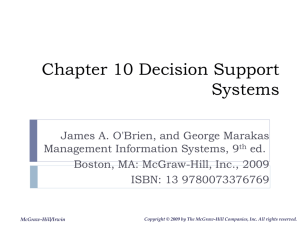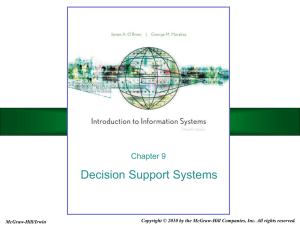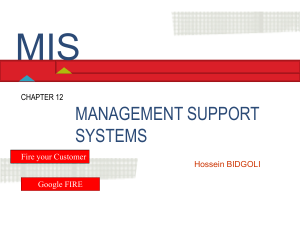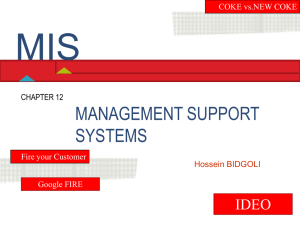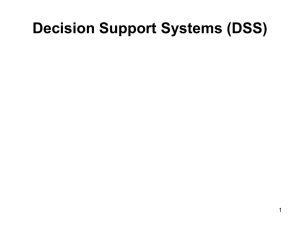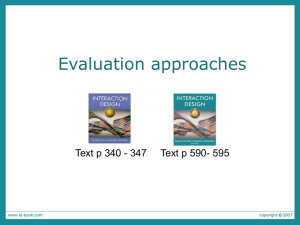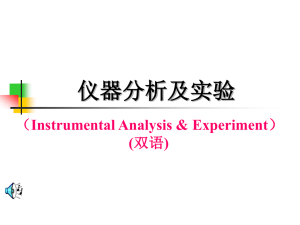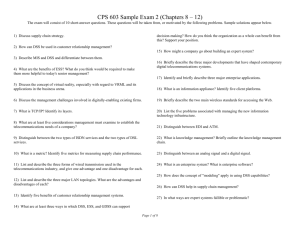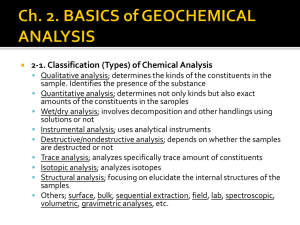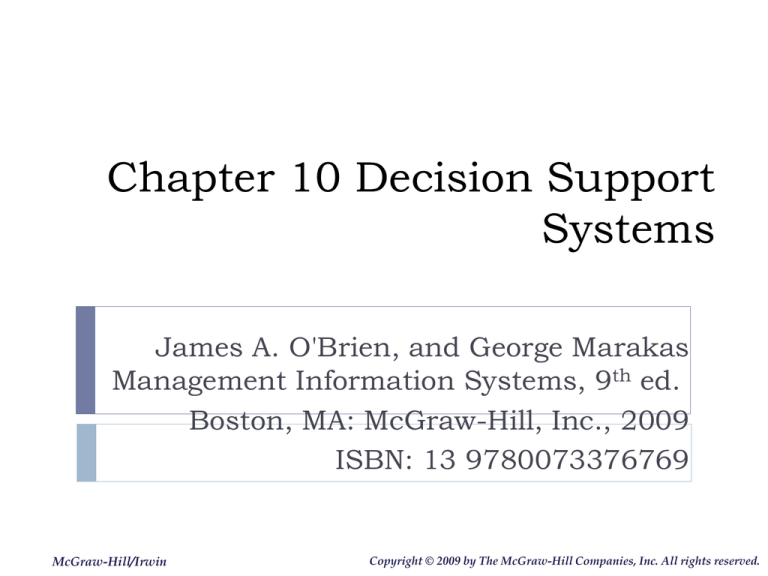
Chapter 10 Decision Support
Systems
James A. O'Brien, and George Marakas
Management Information Systems, 9th ed.
Boston, MA: McGraw-Hill, Inc., 2009
ISBN: 13 9780073376769
McGraw-Hill/Irwin
Copyright © 2009 by The McGraw-Hill Companies, Inc. All rights reserved.
Learning Objectives
1.
2.
3.
4.
5.
6.
7.
Identify the changes taking place in the form and use of decision
support in business
Identify the role and reporting alternatives of management
information systems
Describe how online analytical processing can meet key
information needs of managers
Explain the decision support system concept and how it differs
from traditional management information systems
Explain how the following information systems can support the
information needs of executives, managers, and business
professionals: EIS, Enterprise information portals, and KMS
Identify how neural networks, fuzzy logic, genetic algorithms,
virtual reality, and intelligent agents can be used in business
Give examples of several ways expert systems can be used in
business decision-making situations
10-2
Decision Support in Business
Companies are investing in data-driven
decision support application frameworks to
help them respond to
Changing market conditions
Customer needs
This is accomplished by several types of
Management information
Decision support
Other information systems
10-3
Levels of Managerial Decision Making
10-4
Information Quality
Information products made more valuable by
their attributes, characteristics, or qualities
Information that is outdated, inaccurate, or
hard to understand has much less value
Information has three dimensions
Time
Content
Form
10-5
Attributes of Information Quality
10-6
Decision Structure
Structured (operational)
Unstructured (strategic)
The procedures to follow when decision
is needed can be specified in advance
It is not possible to specify in advance
most of the decision procedures to follow
Semi-structured (tactical)
Decision procedures can be pre-specified,
but not enough to lead to the correct decision
10-7
Decision Support Systems
Management Information
Systems
Decision Support
Systems
Decision
support
provided
Provide information about
the performance of the
organization
Provide information and
techniques to analyze
specific problems
Information
form and
frequency
Periodic, exception,
demand, and push reports
and responses
Interactive inquiries and
responses
Information
format
Prespecified, fixed format
Ad hoc, flexible, and
adaptable format
Information produced by
extraction and manipulation
of business data
Information produced by
analytical modeling of
business data
Information
processing
methodology
10-8
Decision Support Trends
The emerging class of applications focuses on
Personalized decision support
Modeling
Information retrieval
Data warehousing
What-if scenarios
Reporting
10-9
Business Intelligence Applications
10-10
Decision Support Systems
Decision support systems use the following to
support the making of semi-structured business
decisions
Analytical models
Specialized databases
A decision-maker’s own insights and judgments
An interactive, computer-based modeling process
DSS systems are designed to be ad hoc,
quick-response systems that are initiated and
controlled by decision makers
10-11
DSS Model Base
Model Base
A software component that consists of
models used in computational and analytical
routines that mathematically express relations
among variables
Spreadsheet Examples
Linear programming
Multiple regression forecasting
Capital budgeting present value
10-12
Applications of Statistics and Modeling
Supply Chain: simulate and optimize supply
chain flows, reduce inventory, reduce stock-outs
Pricing: identify the price that maximizes
yield or profit
Product and Service Quality: detect quality
problems early in order to minimize them
Research and Development: improve quality, efficacy,
and safety of products and services
10-13
Management Information Systems
The original type of information system
that supported managerial decision making
Produces information products that support
many day-to-day decision-making needs
Produces reports, display, and responses
Satisfies needs of operational and tactical decision makers
who face structured decisions
10-14
Management Reporting Alternatives
Periodic Scheduled Reports
Exception Reports
Reports about exceptional conditions
May be produced regularly or when an
exception occurs
Demand Reports and Responses
Prespecified format on a regular basis
Information is available on demand
Push Reporting
Information is pushed to a networked computer
10-15
Online Analytical Processing (OLAP)
Enables managers and analysts to examine
and manipulate large amounts of detailed and
consolidated data from many perspectives
Done interactively, in real time, with rapid
response to queries
10-16
Online Analytical Operations
Consolidation
Drill-Down
Aggregation of data
Example: data about sales offices rolled up
to the district level
Display underlying detail data
Example: sales figures by individual product
Slicing and Dicing
Viewing database from different viewpoints
Often performed along a time axis
10-17
Geographic Information Systems (GIS)
DSS uses geographic databases to construct and
display maps and other graphic displays
Supports decisions affecting the geographic
distribution of people and other resources
Often used with Global Positioning Systems (GPS)
devices
10-18
Data Visualization Systems (DVS)
Represents complex data using interactive,
three-dimensional graphical forms (charts,
graphs, maps)
Helps users interactively sort, subdivide,
combine, and organize data while it is in its
graphical form
10-19
Using Decision Support Systems
Using a decision support system involves an
interactive analytical modeling process
Decision makers are not demanding
pre-specified information
They are exploring possible alternatives
What-If Analysis
Observing how changes to selected variables affect
other variables
10-20
Using Decision Support Systems
Sensitivity Analysis
Goal-seeking Analysis
Observing how repeated changes to a single variable
affect other variables
Making repeated changes to selected variables until a
chosen variable reaches a target value
Optimization Analysis
Finding an optimum value for selected variables, given
certain constraints
10-21
Data Mining
Provides decision support through knowledge
discovery
Analyzes vast stores of historical business data
Looks for patterns, trends, and correlations
Goal is to improve business performance
Types of analysis
Regression
Decision tree
Neural network
Cluster detection
Market basket analysis
10-22
Market Basket Analysis
One of the most common uses for data mining
Determines what products customers purchase
together with other products
Results affect how companies
Market products
Place merchandise in the store
Lay out catalogs and order forms
Determine what new products to offer
Customize solicitation phone calls
10-23
Executive Information Systems (EIS)
Combines many features of MIS and DSS
Provide top executives with immediate and
easy access to information
Identify factors that are critical to accomplishing
strategic objectives (critical success factors)
So popular that it has been expanded to managers,
analysis, and other knowledge workers
10-24
Features of an EIS
Information presented in forms tailored to the
preferences of the executives using the system
Customizable graphical user interfaces
Exception reports
Trend analysis
Drill down capability
10-25
Enterprise Information Portals
An EIP is a Web-based interface and integration of
MIS, DSS, EIS, and other technologies
Available to all intranet users and select
extranet users
Provides access to a variety of internal and external business
applications and services
Typically tailored or personalized to the user
or groups of users
Often has a digital dashboard
Also called enterprise knowledge portals
10-26
Expert Systems
An Expert System (ES)
A knowledge-based information system
Contain knowledge about a specific, complex application area
Acts as an expert consultant to end users
10-27
Components of an Expert System
Knowledge Base
Facts about a specific subject area
Heuristics that express the reasoning procedures of an
expert (rules of thumb)
Software Resources
An inference engine processes the knowledge
and recommends a course of action
User interface programs communicate with
the end user
Explanation programs explain the reasoning process to
the end user
10-28
Components of an Expert System
10-29
Methods of Knowledge Representation
Case-Based
Knowledge organized in the form of cases
Cases are examples of past performance, occurrences,
and experiences
Frame-Based
Knowledge organized in a hierarchy or
network of frames
A frame is a collection of knowledge about
an entity, consisting of a complex package
of data values describing its attributes
10-30
Methods of Knowledge Representation
Object-Based
Knowledge represented as a network of objects
An object is a data element that includes both data
and the methods or processes that act on those data
Rule-Based
Knowledge represented in the form of rules
and statements of fact
Rules are statements that typically take the
form of a premise and a conclusion (If, Then)
10-31
Expert System Application
Categories
Decision Management
Diagnostic/Troubleshooting
Loan portfolio analysis
Employee performance evaluation
Insurance underwriting
Equipment calibration
Help desk operations
Medical diagnosis
Software debugging
Design/Configuration
Computer option installation
Manufacturability studies
Communications networks
10-32
Expert System Application
Categories (cont’d)
Selection/Classification
Material selection
Delinquent account identification
Information classification
Suspect identification
Process Monitoring/Control
Machine control (including robotics)
Inventory control
Production monitoring
Chemical testing
10-33
Benefits of Expert Systems
Captures the expertise of an expert or group of
experts in a computer-based information system
Faster and more consistent than an expert
Can contain knowledge of multiple experts
Does not get tired or distracted
Cannot be overworked or stressed
Helps preserve and reproduce the knowledge of human
experts
10-34
Limitations of Expert Systems
Limited focus
Inability to learn
Maintenance problems
Development cost
Can only solve specific types of problems in a
limited domain of knowledge
10-35
Knowledge Engineering
A knowledge engineer
Works with experts to capture the knowledge (facts and
rules of thumb) they possess
Builds the knowledge base, and if necessary,
the rest of the expert system
Performs a role similar to that of systems
analysts in conventional information systems development
10-36
Intelligent Agents
A software surrogate for an end user or a
process that fulfills a stated need or activity
Uses built-in and learned knowledge base
to make decisions and accomplish tasks in
a way that fulfills the intentions of a user
Also call software robots or bots
10-37
User Interface Agents
Interface Tutors – observe user computer operations,
correct user mistakes, provide hints/advice on efficient
software use
Presentation Agents – show information in a variety of
forms/media based on user preferences
Network Navigation Agents – discover paths
to information, provide ways to view it based
on user preferences
Role-Playing – play what-if games and other roles to help
users understand information and make better decisions
10-38
Information Management Agents
Search Agents – help users find files and databases, search
for information, and suggest and find new types of
information products, media, resources
Information Brokers – provide commercial services to
discover and develop information resources that fit business
or personal needs
Information Filters – Receive, find, filter, discard, save,
forward, and notify users about products received or
desired, including e-mail, voice mail, and other information
media
10-39

